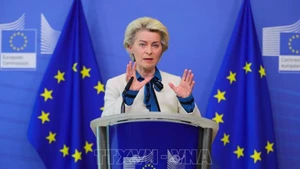According to the UN, the global economy is forecast to grow 2.7% in 2024 and 2.8% in 2025, a slight increase compared to the forecast of 2.4% for 2024 and 7% for 2025 made at the beginning of the year. The world economic growth forecast has been improved thanks to a more optimistic outlook for the "economic locomotive" of the US, with the country poised to achieve growth of 2.3% this year, as well as some leading emerging economies such as Brazil, India, and Russia.
China's economy is forecast to grow by 4.8% in 2024, up slightly from the 4.7% forecast in January.
Meanwhile, the UN has lowered its economic growth forecast in the European Union (EU) from 1.2% to 1%. Geopolitical tensions and uncertainty about the direction of economic policy in 2024 have posed potential risks to the financial stability of the eurozone. The European Central Bank (ECB) said that economic conditions have improved compared to the previous six-month assessment, but the outlook is still fragile.
The UN’s updated report forecasts that economies in the East Asia region in general will achieve growth of 4.6% in 2024 and 4.5% in 2025, unchanged from the previous forecast in January. This result has been underpinned by strong domestic demand, the continued recovery of the tourism industry, and signs of improvement in goods exports. However, there are still factors that threaten to dampen the growth outlook, including higher policy rates for longer in developed economies, escalating geopolitical tensions, and increasing climate risks.
Export-oriented East Asian economies, such as Malaysia, Singapore, Taiwan (China), and Vietnam, have been showing signs of trade recovery since late 2023, especially regarding the export of electrical products. These are positive signals and "bright spots" in the global economic picture. The world economy has been gaining important growth drivers.
According to the assessment by the International Monetary Fund (IMF), the economic growth prospects of Asia-Pacific in 2024 are brighter, with the expectation that the region's economy will decelerate less than expectations as inflationary pressures continue to decline. The IMF also raised its growth forecast for this region this year to 4.5%, an increase of 0.3 percentage points compared to the previous six month period.
Despite raising the global growth forecast, the UN’s report also said that the economic outlook is only cautiously optimistic, due to persistent high interest rates, bad debt, and the escalation of geopolitical risks continuing to act as barriers to stable and sustainable growth.
Severe climate shocks pose additional challenges to the global economic outlook, putting development achievements of many decades at risk. Rapid changes in technology, including artificial intelligence (AI), have been bringing many new opportunities and risks to the world economy. Meanwhile, high interest rates, tight fiscal space, and geopolitical risks are said to erode investment growth.
Global investment has been continuing its downward trend since 2021, with investment growth, which is measured by real gross fixed capital, estimated to have reached 2.8% in 2023. This reflected a sharp decline in investment growth among developing economies, falling from 5.1% in 2022 to 3.7% in 2023. Global goods trade growth remains weak. Merchandise trade turnover has declined continuously since mid-2022 and will continue to decrease by 5% in 2023.
A strong dollar has become a burden on import activities, especially in developing countries, and in fact South-South trade transactions decreased by as much as 7% in 2023. In contrast, the volume of trade in goods grew slightly again, signaling a recovery in global demand for imported goods and an expected recovery in global trade in 2024.
Although cautious optimism about the global economy is starting to dominate forecasts, many challenges remain. The recovery has been uneven across regions, while macroeconomic forecasts continue to face mixed developments, with inflation and interest rates falling at different speeds and with different needs for the improvement of financial situations. In addition, geopolitical tensions could disrupt energy and financial markets, causing inflation to skyrocket and hindering global economic growth.














